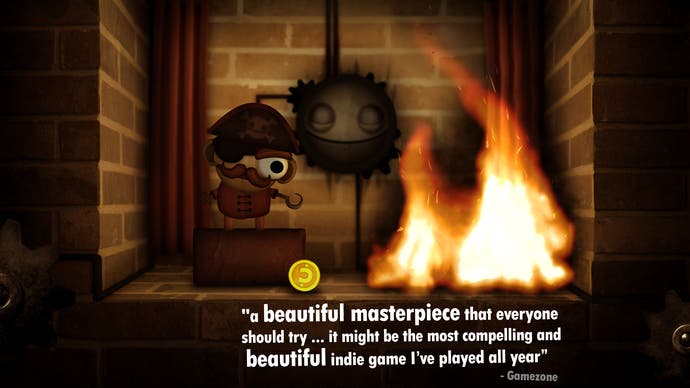Someone should make a game about: chimneys
Step in time.
My grandmother had a chimney in her house, and all the rituals that went with it. All week she would set aside time for the making of spills - little concertinas of newspaper that were good for getting fires going. She would keep an eye on the log pile, and if any of us had an orange, we would save the peel for her to toss into the flames when the fire was lit. This last part I remember so strongly that I still find myself holding onto orange peel for a few seconds whenever I'm eating an orange, before I remember that my grandmother died in 1991. Anyway, the rituals extended to the fire itself. She would stare into the flames and, in fact, through the flames. The sooty back wall of the fireplace would become home to little orange embers that would advance up and down as the fire progressed and she liked to watch them.
Someone should make a game about chimneys. But hearths? That's really what my grandmother's rituals were all about, and somebody has made a game about hearths already. Little Inferno is a game about buying stuff to burn it, and I can take the thudding heft of its satire because the game is so beautiful when it comes to the details. You are presented with a hearth and you chuck things in. You move the fire around with a mouse or a finger. Woomf! Delicious.

But what about chimneys? The flue and the, the rest of it? Is that the chimney? Where does the flue end? Is the flue the whole thing? Confusion reigns.
What I love about chimneys the most - and what I suspect is most game-like - is captured in a quietly startling short story by Herman Melville, I and my Chimney. I always think this story is part of the Piazza Tales, but it's a loose fish rather than a fast fish. It swims alone.
It's extremely odd. The elderly narrator tells the story of his unusual house which is built around a gigantic chimney, which goes right through the centre of it. The chimney is uncommonly large and the house itself bends to the demands of the chimney. As does the narrator, who, over the course of the story, starts to identify with the chimney to a troubling degree. The narrator's family hate the chimney, and an engineer brought around to inspect it suggests it should be torn down. He also suspects it contains a secret chamber. It's a moral matter. ""It is my solemn duty to warn you, sir, that there is architectural cause to conjecture that somewhere concealed in your chimney there is a reserved space... Trusted that you may be guided aright, in determining whether it is Christian-like, knowingly, to reside in a house, hidden in which is a secret closet.""
By the end of the story, everyone but the narrator wants the chimney gone. And they all have plans for its destruction. On the last page, the narrator reveals that he has not left his home in seven years because if he does the chimney will fall.
When I first read I and my Chimney, I assumed it was a sort of early run of the ideas you find in Bartleby, the classic Melville story in which a clerk refuses to do any writing, and eventually anything at all. I was delighted to discover that in fact it's much stranger. If anything, Bartleby, published in 1853, is an early run of the ideas in I and my Chimney, which followed three years later. It is a weird story! But maybe, setting aside the heavy symbolism - it has been written that both Freud and Jung could have a good time with I and my Chimney - part of this is because chimneys are quite weird.
Here is a passage I particularly love. "Each flue is surreptitiously honeycombed into the walls; so that these last are here and there, or indeed almost anywhere, treacherously hollow." Surreptitious, treacherous. Perhaps the thing I love about chimneys is that they live around us but secretly. Live in a house with a chimney - renting in Brighton for years and it was impossible not to - and there are parts of your house very close by that you will never see, never get to know, and never understand. "To reside in a house, knowingly..."?

Secret landscapes and spaces folded around us, threading through the world we live in. This is where chimneys and games could really do some damage together. The closest thing I can think of is Creaks, the Amanita Design game, in which you explore a wonderfully cramped and intricate series of attics and anterooms. But then I think too of that great bit in Dark City, where the hero is hanging off the wall of a building that is transforming around him, seconds from falling to his death, when a chimney races up alongside him and he leaps on, the chimney carrying him to the roof.
Chimneys are about as inside as houses get - they exist inside the insides of houses. Little engineering solutions, with their own mysteries and secrets. That sounds perfect for games.


